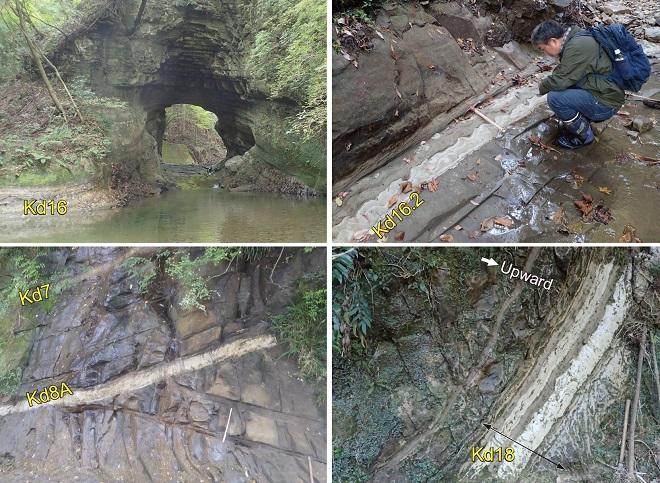Bulletin of the Geological Survey of Japan Top Page
Bulletin of the Geological Survey of Japan Vol.70 No.6 (2019)
Cover photograph | Table of Contents | Abstract
Cover photograph
LaTephra beds in the Kiwada Formation
Upper left:Kd16 exposed in the Yuki River, Otaki Town. An opening in the middle is one of the tunnels called
“Kawamawashi”. They were excavated for agricultural use of abandoned river channels and are commonly
seen in the area where the Kazusa Group is exposed.
Upper right: Kd16.2 exposed in a branch stream of the Yuki River, Otaki Town. It is correlated with the tephra bed
called “Kd11” in the Isumi City.
Lower left: Kd8A and Kd7 in a submarine landslide deposit block exposed along the Isumi River, Otaki Town. The
basal slip plane (ramp) immediately below Kd8A cuts up through the footwall strata. The length of the white
stick in the lower right is 50 cm.
Lower right: Kd18 in an overturned submarine landslide deposit block exposed along the Ono River, Isumi City.
The length of the pickaxe in the lower right is 60 cm.
(Photograph and Caption by Masayuki Utsunomiya)
Table of Contents
All the pages PDF : 70_06_full.pdf [40MB]
| Title | Author | |
|---|---|---|
| Article | ||
| Stratigraphic positions and characteristics of tephra beds in the lower to middle Kiwada Formation (lower Pleistocene), Kazusa Group | Masayuki Utsunomiya, Kiyohide Mizuno and Itoko Tamura (p373-441) | 70_06_01.pdf [38MB] |
Abstract
Stratigraphic positions and characteristics of tephra beds in the lower to middle Kiwada Formation (lower Pleistocene), Kazusa Group
Masayuki Utsunomiya, Kiyohide Mizuno and Itoko Tamura
The lower to middle Pleistocene Kazusa Group on central Japan is known as one of the stratotype sections of the NW Pacific region, owing to the abundant tephra beds which enable precise correlation. A robust chronological framework obtained with helps of biostratigraphy and magnetostratigraphy provide highly resolved depositional age of the tephra beds and temporal variation of the volcanic activities around this region (i.e., the Honshu and Izu-Bonin arcs). The lower Pleistocene Kiwada Formation in the Kazusa Group is a deep-marine, siltstone-dominated strata (720 m in total thickness) in which many (>200) well-preserved tephra beds are intercalated. However, there have been some confusions in the stratigraphic relation among the tephra beds.
This paper reports stratigraphic positions, outcrop occurrences, petrographic characteristics, accompanied with major and trace element composition of volcanic glass of the selected marker tephra beds and previously undescribed tephra beds. The undescribed tephra beds were numbered in descending stratigraphic order and prefixed with‘Kd’, following notation of the previous studies. The continuous tephrostratigraphy and chemical characteristics of the tephra beds in the Kiwada Formation would contribute further investigation for regional correlation of Japanese Quaternary sections and volcanic activities around NW Pacific region.
Geological Survey of Japan, AIST
- About GSJ
- Our Activities
- Purchase guide
-
Publications and Database
- information
- Bulletin of the Geological Survey of Japan
- bull2025(Vol.76)
- bull2024(Vol.75)
- bull2023(Vol.74)
- bull2022(Vol.73)
- bull2021(Vol.72)
- bull2020(Vol.71)
- bull2019(Vol.70)
- bull2018(Vol.69)
- bull2017(Vol.68)
- bull2016(Vol.67)
- bull2015(Vol.66)
- bull2014(Vol.65)
- bull2013(Vol.64)
- bull2012(Vol.63)
- bull2011(Vol.62)
- bull2010(Vol.61)
- bull2009(Vol.60)
- bull2008(Vol.59)
- bull2007(Vol.58)
- bull2006(Vol.57)
- bull2005(Vol.56)
- bull2004(Vol.55)
- bull2003(Vol.54)
- bull2002(Vol.53)
- bull2001(Vol.52)
- Bulletin of the Geological Survey of Japan(old)
- Annual Report on Active Fault and Paleoearthquake Researches
- Reports, Geological Survey of Japan
- CCOP-GSJ Groundwater Project Report
- CCOP Technical Bulletin
- Cruise Report
- Geological Hazards
- Learning and Education
- GSJ Database Collection
- Collection of links


